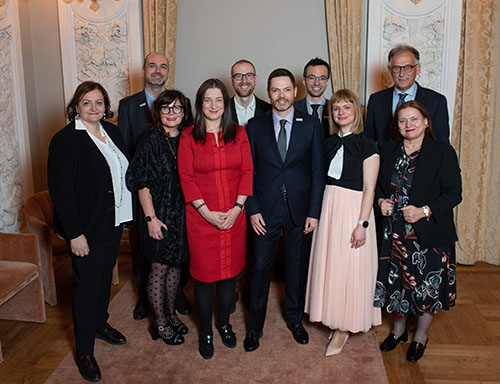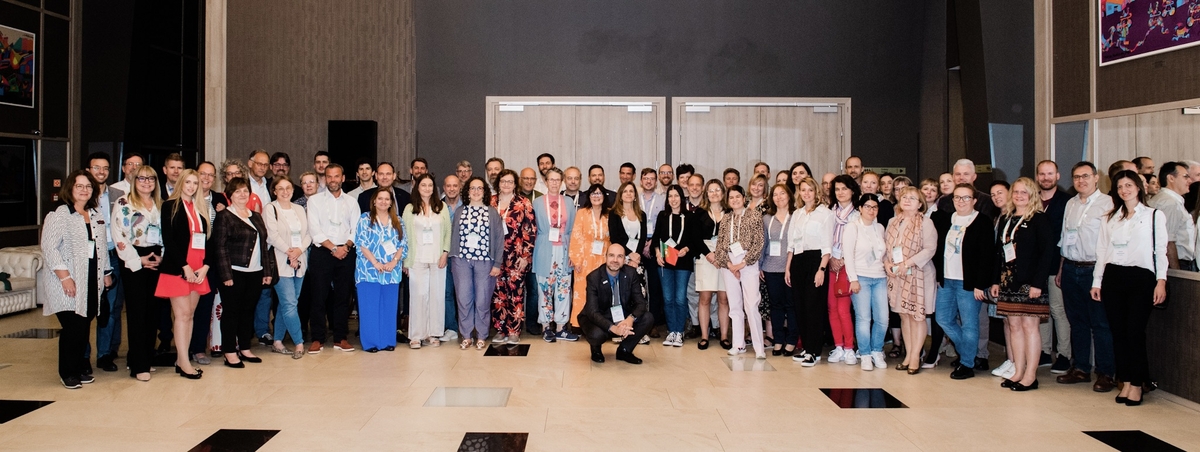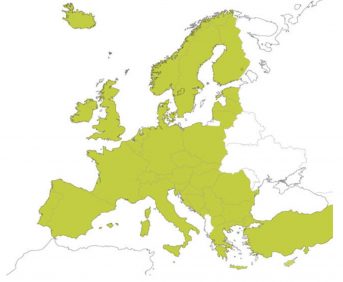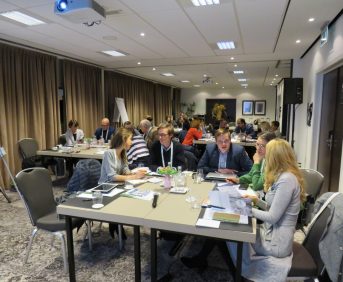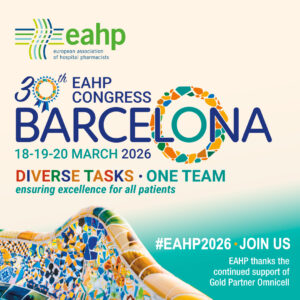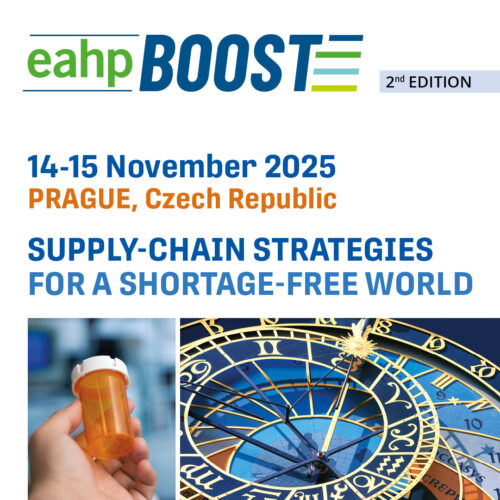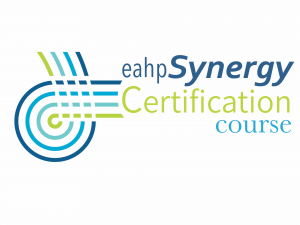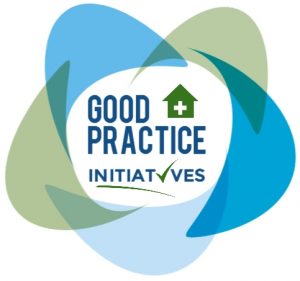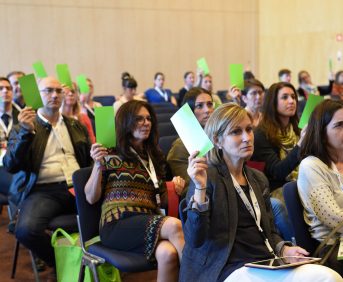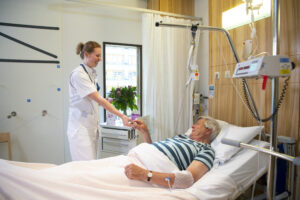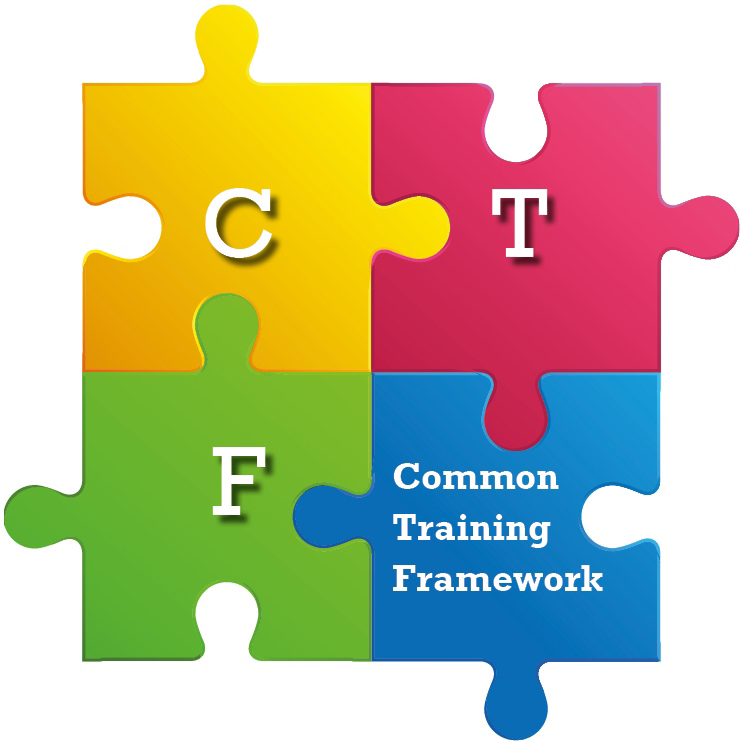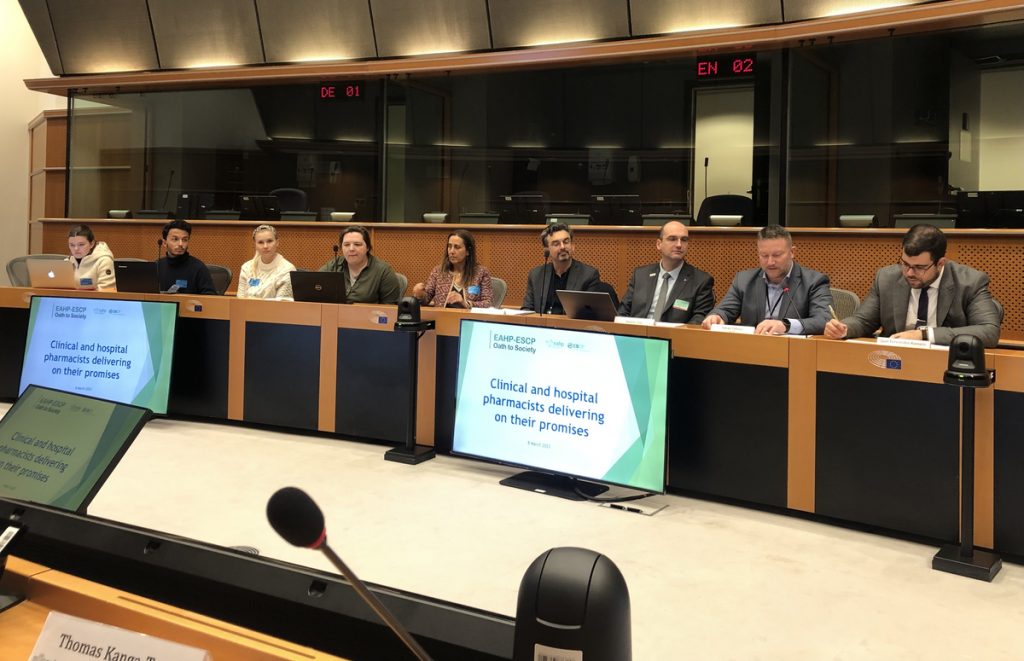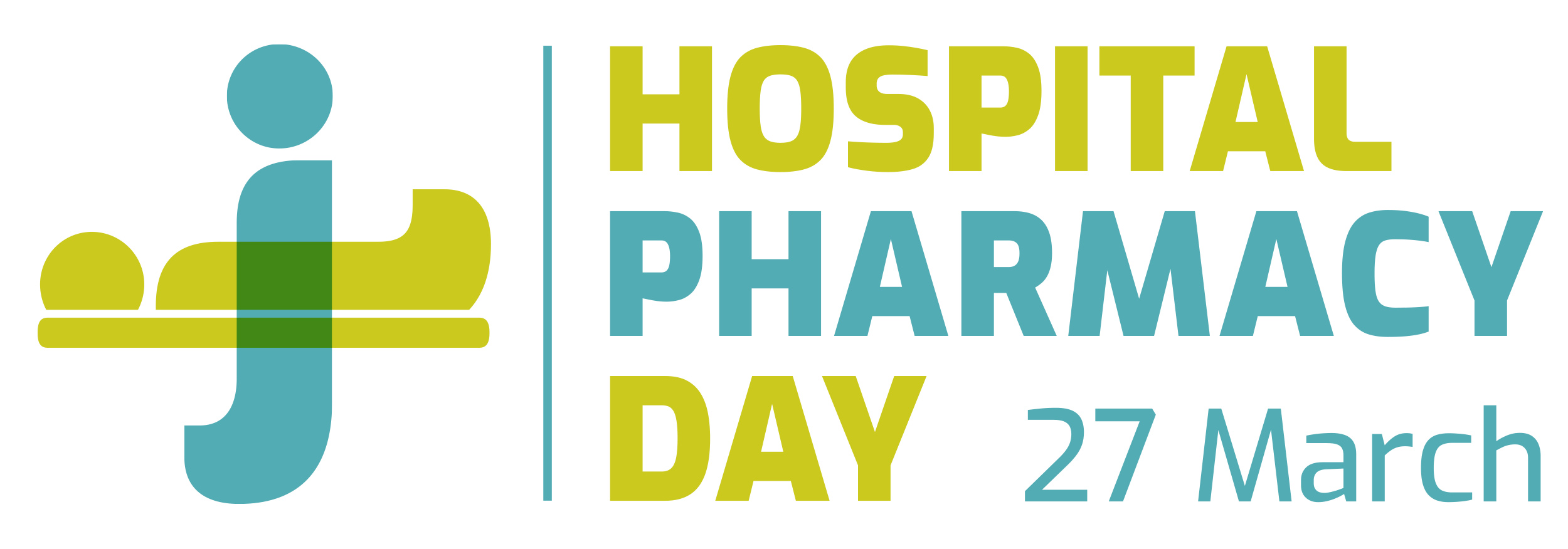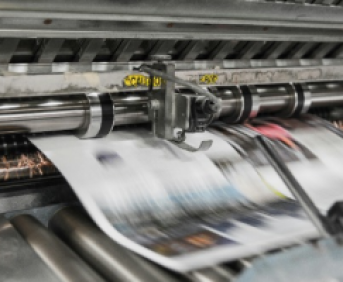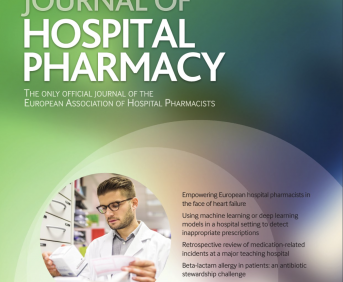DEPRESCRIBING IN OLDER ADULTS: LET’S TALK!
Pdf

European Statement
Clinical Pharmacy Services
Author(s)
Steffy LEFAKOUONG, Mohamed MOSTEFA, Sarah BARBIEUX, Sophie VERNARDET, Isabelle LEFORT
Why was it done?
Institutional and multidisciplinary work has been carried out in the hospital since 2022 on reducing prescriptions of potentially inappropriate medications (PMIs) in older population (OP), in accordance with french recommandations.
What was done?
Our aim is to raise awareness among medical staff on the prescription of PMIs in OP through continuing education (CE) courses.
How was it done?
A PMI-specialized team composed of 2 geriatricians, 1 pharmacist and 1 pharmacy intern was formed.
CE is planned in the form of a structured medication review describing clinical cases based on discharge prescriptions of hospitalized patients, selected according to several criterias: >75 years old, ≥1 PMI on the prescription.
These prescriptions are analyzed by the specialized team using various reference documents, with a relevance audit grid provided by the regional drug authority as a basis.
The first MR was presented to the doctors and residents of the establishment’s various departments during a joint session.
A satisfaction survey was created to assess the interest and relevance of the course.
What has been achieved?
For our first session, we selected 3 prescriptions : two containing 4 PMIs each and one containing 2 PMIs.
A detail of each PMI was carried out with a focus on two main themes : deprescribing long-acting benzodiazepines and proton pump inhibitors.
Besides PMIs, a comprehensive prescription analysis was done by mentioning inadequate prescriptions from a geriatric medical view.
In total, we have a participation of 100% of the pharmacists, 89% of the geriatricians and 100% of pharmacy residents. Among the other departments, only 3 other physicians participated in the course.
According to the survey, 100% of participants said they were satisfied with the session and 44% wanted more interactive training.
What next?
The high participation of pharmacists and geriatricians, 2 teams of interest in the process of deprescribing MPIs, highlights the usefulness of this CE among healthcare professionals.
The structure of the session encourages constructive and collaborative exchanges while comparing visions of different professionals.
Nonetheless, a reflection on our approach’s appeal is necessary in order to increase the participation rate of physicians and medical residents absent during the session.
The satisfaction rate remains encouraging, and pushes us to renew this training periodically.
DRIVING CHANGE IN ANTIBIOTIC STEWARDSHIP: A PHYSICIAN-PHARMACIST COLLABORATION IN THE ICU AND SURGICAL WARDS (IN VIENNA)
European Statement
Clinical Pharmacy Services
Author(s)
Lisa Wimmer, Beata Laszloffy, Tamara Clodi-Seitz, Doris Haider
Why was it done?
Antibiotic resistance poses a serious threat to global health, and Austria’s National Action Plan on Antibiotic Resistance (NAP-AMR) highlights the urgency of robust antibiotic stewardship, especially with the 2024 implementation of new antimicrobial quality standards. In response, a 700-bed hospital in Vienna has launched an ambitious initiative, forming a dedicated Antibiotic Stewardship (ABS) team. This interdisciplinary collaboration between physicians and clinical pharmacists is designed to revolutionize antibiotic use, curb resistance, and elevate patient care standards starting in the ICU and associated surgical units.
What was done?
The ABS team took decisive action by targeting one intensive care unit (ICU) and two surgical wards (64 beds in total) for weekly screenings. Infectious disease specialists and clinical pharmacists worked hand-in-hand, meticulously reviewing every patient’s case. This dynamic collaboration ensured not only the highest level of medication safety but also the relentless optimization of antibiotic use, pushing boundaries to meet and exceed best-practice standards.
How was it done?
The ICU and surgical wards—hotspots for antibiotic overuse—were strategically chosen for weekly reviews. In these high-risk areas, an interdisciplinary collaboration of physicians and clinical pharmacists joined forces, taking swift action to assess and fine-tune prescriptions. Pharmacists played a hands-on role, actively reviewing antibiotics and other medications, making recommendations, adjusting dosages, and halting unnecessary treatments. This collaboration was crucial in driving evidence-based decisions that directly elevated patient care to new heights.
What has been achieved?
After just four months, the project has already made significant strides, affecting a substantial number of patients. The majority of interventions have centered on refining antibiotic use, while additional recommendations on other medications have strengthened overall treatment safety. This close collaboration between physicians and pharmacists has directly improved adherence to national guidelines and sharpened prescribing practices.
What next?
Building on early successes, the ABS team will expand screening to additional departments, establishing a pivotal role for clinical pharmacists. This initiative serves as a model for other hospitals, demonstrating that significant improvements in antibiotic stewardship are possible, even with limited resources. The key takeaway: small steps can drive substantial gains in patient care and antibiotic use. As the program progresses, measurable effects on resistance patterns and antibiotic consumption are anticipated.
IMPLEMENTATION OF A MULTIDISCIPLINARY PHARMACOKINETIC-PHARMACOGENETIC UNIT
Pdf

European Statement
Clinical Pharmacy Services
Author(s)
Jose Luis Sánchez Serrano, Ana Valladolid Walsh, Andrea Drodz Vergara, Carolina Andrés Fernández, Laura Navarro Casado
Why was it done?
Due to a reorganization of health professionals in our hospital, we identified an opportunity to include in our clinical services the preparation of pharmacokinetic reports for all drugs for which blood levels were carried out both at the hospital and external laboratories.
What was done?
We have implemented a multidisciplinary pharmacokinetic-pharmacogenetic unit with the Laboratory Department in our hospital. Until the end of 2023 we participated in the preparation of pharmacokinetic reports for a limited number of drugs in inpatients, basically in haematological and critical patientes. After this, we have included this clinical service for all drugs for which levels were carried out at the hospitalization and outpatient level.
How was it done?
The first step was to present a joint project to the hospital management to reorganize this activity and meet with medical departments to identify their needs and areas of improvement.
At the same time we acquired and implemented a specific software to assist us with the elaboration of recommendations.
We included training sessions in pharmacokinetics for pharmacists in the Pharmacy Department´s annual training program, in addition to offering an external course on Pharmacogenetics Course for staff pharmacists.
As to the clinical services offered, the project has gone through two stages:
• First stage (1 month duration): We reviewed all requests for drug levels obtained both from hospital and primary care level.
• Second stage (10 months duration): The pharmacist monitors all drug serum levels of narrow therapeutic margin and monoclonal antibodies both at the hospitalization and outpatient level. We have updated the available catalogue of drug serum concentrations tests in our center including Voriconazole, Linezolid, Ustekinumab, Adalimumab and Infliximab.
What has been achieved?
We have improved the whole process from ordering tests to sample extraction, serum level determination, and making recommendations in both inpatients and outpatients.
An average of about 160 pharmaceutical interventions per month are done with a 95% acceptability.
What next?
Our future objectives include updating the available pharmacogenetic testing in this unit in order to include recommendations based on test results.
IMPLEMENTATION OF ELASTOMERIC INFUSION PUMPS FOR THE ADMINISTRATION OF ANTIMICROBIAL AGENTS IN COORDINATION WITH HOME HOSPITALIZATION
Pdf

European Statement
Clinical Pharmacy Services
Author(s)
Eva Gómez-Costa; María Begoña Feal-Cortizas; María Mateos-Salvador; Sandra Rotea-Salvo; Andrea Luaces-Rodríguez; Laura Caeiro-Martínez; Clara Fernández-Diz; Andrés Torres-Pérez; Luis Margusino-Framiñán; María Isabel Martín-Herranz
Why was it done?
Implementation of a circuit for the preparation and dispensing of elastomeric infusion pumps (EIPs) prepared in a Hospital Pharmacy Service, designed for the continuous intravenous administration of antimicrobial agents in coordination with Home Hospitalization Units (HHU).
What was done?
The purpose of this initiative is to provide an effective and safe alternative for treating infections in patients who would otherwise require prolonged hospital stays. The use of EIPs improves patients’ quality of life and reduces treatment costs by decreasing hospital admissions.
How was it done?
The Pharmacy Service contributed to the development of this initiative by studying the stability of antimicrobial agents in the EIPs, determining dilution volumes based on the maximum possible concentration, and assessing storage conditions, among other factors. The appropriate EIP was selected for each antibiotic to ensure effective and safe infusion rates. EIPs are prepared in laminar flow hoods to maintain a sterile environment during medication preparation. Additionally, educational materials for healthcare professionals were developed, and training sessions were conducted for HHU staff.
What has been achieved?
In 2023, a total of 2,223 EIPs were prepared to treat 123 patients, resulting in a reduction of 1,426 hospital days. Compared to previous years, there was a 243% increase in the number of infusers and a 131% increase in the number of patients between 2017 and 2019. Between 2019 and 2023, there was an 11.9% increase in infusers and a 36.7% increase in patients.
The antimicrobials used were: meropenem (59.6%), piperacillin/tazobactam (19.9%), cefazolin (6.8%), ceftazidime (5.6%), ceftaroline (2.2%), penicillin G (2.1%), tobramycin (1.5%), ampicillin (0.7%), acyclovir (0.6%), ceftolozane/tazobactam (0.6%), and ceftriaxone (0.4%).
What next?
Future research is expected to expand on the efficacy and safety of this methodology by studying stability times at different concentrations of agents antimicrobials to establish a sustainable model that can benefit an increasing number of patients. Additionally, patient surveys will be conducted to gather insights into their experiences and enhance their quality of life.
INTERNSHIP OF RESIDENT PHARMACISTS IN NEONATOLOGY CARE UNIT AT ULSSA: A COLLABORATIVE APPROACH
Pdf

European Statement
Clinical Pharmacy Services
Author(s)
Rita Sofia Conde Lopes, Rita Manuel Neves Lopes, Ana Paula Barbeita, Teresa Cunha, Patrocínia Rocha
Why was it done?
Improving the training of PRs and supporting the neonatal medical team by addressing their needs.
What was done?
The Pharmaceutical Residency (PR) lasts four years, during which the Resident Pharmacist (RP) must acquire skills in various areas. In the PR, one of the longest functional areas is pharmacotechnics, which includes the handling of sterile and non-sterile medicines. At the Unidade Local de Saúde de Santo António (ULSSA), which includes the Centro Materno Infantil do Norte (CMIN), this type of preparation is crucial due to the type of population it serves — pediatrics. With this in mind, the RP had the opportunity to complete a one-month internship in the neonatology unit (NU), where, in addition to familiarizing with the unit’s routine, they assisted with various needs of the service.
How was it done?
PRs attended morning routine specialist doctors during the morning routine, participating in both the night-morning and morning-afternoon shift handovers and follow-ups. The schedule was coordinated between the Pharmaceutical Services (PS) and the NU to ensure this was the most productive time for both parties. During shift changes, any issues from the previous period were discussed. When these topics involved the FS, the PR provided assistance.
What has been achieved?
During their presence NU, PR were able to intervene in several key areas, including expediting Pharmacy and Therapeutics Committee authorizations (e.g., everolimus for a neonate with rhabdomyoma), managing the logistics for obtaining non-commercialized medication in Portugal (e.g., erythromycin oral suspension for prokinetic use), supporting clinical decisions regarding the prescription of parenteral nutrition bags, updating the medical prescription system for dressing materials (e.g., maltodextrin powder dressings) and creating a spreadsheet for prescribing protein supplements.
What next?
This collaboration has fostered a stronger connection between pharmaceutical and clinical services and underscores the vital role of multidisciplinary teams in healthcare, where experts from different fields contribute with their specialized knowledge. Such collaboration not only enhances patient outcomes but also optimizes workflows by reducing service duplication, increasing productivity, and saving valuable time. In the future it is expected continue this collaboration.
Hospital pharmacists’ professional empowerment through skills integration: experience of international cooperation between Italy and Tanzania
Pdf

European Statement
Education and Research
Author(s)
Agnese Bosio, Chiara Carcieri, Sixberth Bugeraha, Silvia Scalpello, Giovanna Fazzina, Maria Carmen Azzolina, Gianluca Miglio, Annalisa Gasco
Why was it done?
Drug dispensing and patient monitoring are institutional activities of hospital pharmacists worldwide. Nevertheless, the enhancement of managerial capabilities, hard and soft skills is crucial to tackle the critical challenge arising from geographical, epidemiological, demographic, cultural and legislative differences between different countries.
What was done?
An initiative for cooperation and interaction between hospital pharmacists from different income countries has been developed.
How was it done?
The initiative was led by a pharmacist from an Italian hospital who was hosted by a hospital in southern Tanzania and spent a month collaborating with local hospital pharmacists, in order to streamline integrated workflows and optimise clinical care outcomes and professional training.
What has been achieved?
A Strengths Weaknesses Opportunities Threats (SWOT) matrix was developed to assess the impact on three main areas: drug management, clinical pharmacy and pharmaceutical care.
Strengths: attitude for workflow standardisation, multidisciplinary and multicultural teamwork, sharing of expertise and best practice, speed up of limiting processes in order to develop activities in support of patients and clinicians, time and effectiveness in qualified staff training.
Weaknesses: complexity of procedures for drug import, hospital staff shortage (both pharmacists and physicians), absence of primary care and hospital-territory continuity of care network, clinical severity of patients admitted to hospital, imbalance between clinical pharmacy/pharmaceutical care in favour of drug management.
Opportunities: professional growth due to new healthcare challenges facing, soft skills improvement (problem solving, versatility, working under stress, teamwork, integration, overcoming prejudices), hard skills enhancement (logistics, international legislation, scientific English), budget optimisation for new investments (equipment/staff), improvement of patient safety and overall level of care.
Threats: language/cultural barriers, variable learning curve and resistance to change, barriers in social/professional relationships, individual variability in adaptation period, different patient perceptions of health and medical care.
What next?
Professional integration of hospital pharmacists from different educational and cultural backgrounds could enhance their ability to address different clinical, environmental and socio-economic issues, with the following outcomes: strengthening the professional pathway; optimising outcomes with consequent cost savings; improving the quality of healthcare for patients.
Assesing cold chain compliance for biotherapy drugs in a university hospital’s medical departments
Pdf

European Statement
Patient Safety and Quality Assurance
Author(s)
AMINE BAYEN, OUMAIMA KHARKHACH, HICHAM EL HORR, LHOUSSAIN ZARAYBY, SANAE DERFOUFI
Why was it done?
It has been observed that within the gastroenterology, neurology, internal medicine, rheumatology, and dermatology departments, there exist inconsistencies and disparities. These include extended transportation times averaging 8 minutes, a lack of isothermal bags for transportation, and refrigerators not connected to the main hospital generator.
Strict adherence to storage guidelines is crucial, as any breach in the cold chain could compromise the drug’s therapeutic effectiveness, increase the risk of adverse effects, and lead to significant financial losses for healthcare institutions.
What was done?
Ensuring optimal storage and transportation conditions for biotherapy drugs in various medical departments within a university hospital by assessing and improving cold chain compliance.
How was it done?
Implemented corrective actions and recommendations have been primarily directed towards minimizing transportation duration and procuring thermal bags for all departments handling biotherapy products. These initiatives encompass enhancing staff awareness in the cold chain process through sensitization campaigns and regularly evaluating refrigerator temperatures. Moreover, a strategic plan is underway to establish their connectivity to the generator system in the near term.
What has been achieved?
A notable reduction in the transportation time of biotherapeutic drugs has been achieved, decreasing the average duration from 8 minutes to 6 minutes. Additionally, the widespread adoption of thermal bags across audited departments has substantially bolstered the stability of biotherapeutic drugs, mitigating temperature fluctuations and enhancing patient safety. Moreover, our efforts in sensitising medical and pharmaceutical staff within these departments have yielded a significant increase in awareness and adherence to stringent cold chain protocols.
What next?
The inconsistencies and disparities identified during the assessment of the biotherapy drug cold chain within our hospital suggest a potential lack of adherence to procedural standards. This situation poses a considerable risk to patient safety, warranting further investigation and action.
Our focus will extend beyond the cold chain assessment to evaluate other pharmaceutical procedures. Specifically, we will investigate the adherence to autoclave sterility cycles for medical devices and the robustness of the preparation process for oncology medicines.
Rethinking pharmacy and therapeutics committee procedures to achieve the efficiency required to overcome hospital complexity
Pdf

European Statement
Clinical Pharmacy Services
Author(s)
Sara Rodrigues, Sofia Pinheiro, Vandewalle Björn, Paulo Martins, Sofia Ferreira, Paulo Pereria, Jorge Félix
Why was it done?
Shared decision-making between pharmacists and physicians is key to PTC functioning and efficiency. Responsibilities include managing policies and procedures for appropriate use of high quality and cost-effective health technologies at hospitals. PTC performance is paramount to overall hospital efficiency.
What was done?
This project seeks to assess and redesign (optimize) existing Pharmacy and Therapeutics Committees (PTC) procedures within a University Hospital Centre (UHC – six public hospitals). The goal is to enable sound decision-making that significantly contributes to UHC key performance indicators, all while ensuring timely patient access to effective medication.
How was it done?
The project comprises four phases: (1) gathering feedback from stakeholders (PTC members; hospital service/pharmaceutical department directors) regarding their current involvement in PTC information flows, procedures, and decision-making; (2) developing a value-based criteria-matrix, across stakeholders, in a multiple-criteria decision analysis context, to guide future PTC decision-making; (3) rethinking PTC procedures and information flows; (4) assessing the effectiveness of the redesigned PTC model after 12 months. First phase included: a Likert-scale based survey1 for PTC members to evaluate their involvement in activities described in the internal PTC regulation, and a semi-structured interview-based survey2 for all stakeholders to characterize existing information flows and PTC mediated decision-making processes.
What has been achieved?
First phase: eight of 10 PTC members participated in survey1. Activities with 100% engagement of PTC members: prescription reviews; coordination with National PTC; monitoring of medicine utilization, antibiotics resistance and safety; advise the UHC management board. Activities with major non-engagement: monitoring/reporting of complementary diagnostics prescription (87.5%); medication therapy management programs (62.5%); National pharmacovigilance system activities (62.5%); therapy cost assessment (50%). In survey2 (n=14) authorization process for medicines utilization was accurately characterized, clearly identifying responsibilities for all clinical and pharmaceutical departments. Heterogeneity exists between urgent and non-urgent utilization requests. PTC members and pharmacy departments were more likely to use electronic platforms than clinical departments.
What next?
Next phases are under way to better support current competencies, information flows, procedures, and the shared decision-making processes offering an opportunity to rethink the PTC procedures in the University Hospital Centre and leverage efficiency over hospital complexity.
Using virtual reality to introduce newly hired nurses
Pdf

European Statement
Education and Research
Author(s)
Stine Hygum Sørensen, Henrik Nielsen, Ulla Kloster, Anne Grethe Nørgaard Kyndi, Maja Vad Mortensen, Dorthe Ludvigsen
Why was it done?
The concept of medicine at Gødstrup Hospital is based on Patient involvement in the medicine process. Consequently, the patients bring their own medicine, which is stored in the patient’s room, and additional medicine is supplied in original packages. Medicine dispensing is performed in the patient’s room to allow patient participation. The medicine rooms at the hospital are quite small, because the majority of the medicine is with the patient, but it also makes medicine rooms unsuited for on-site training of new nurses.
What was done?
Virtual Reality (VR) technology was applied for introduction of newly hired nurses to medicine rooms at the hospital.
Newly hired nurses are given a four hour introduction to the concept of medicine at Gødstrup Hospital, Denmark. The introduction is given by an interdisciplinary team of a clinical pharmacist, a pharmacologist and an experienced nurse. The introduction is given in collaboration with the Centre for Research and Education (NIDO) once a month. This ensures that newly hired nurses are given the same, relevant introduction when needed.
Introduction to medicine rooms is part of the training for nurses in introductory positons. Using VR newly hired nurses are given a different and exciting introduction to medicine rooms.
How was it done?
In collaboration with the simulation unit at NIDO we made a VR-video to enable up to 20 new nurses to see the same introduction at the same time. Hospital Pharmacy staff is featured in the VR recording and guides viewers to specific parts of the medicine room, explaining important topics such as waste disposal, hygiene and anatomical therapeutic chemical (ATC) groups.
What has been achieved?
The participants are positive and give the following feedback to the VR segment of the introduction: “It was significantly easier to deal with as a newbie”. “It was very visual as being there in reality”. “There was time to learn in a calm environment”, “It worked fine as a lesson” and “It is a good change from backboard teaching.”
What next?
The monthly introductions continues and further collaboration with NIDO will result in lessons with topics such as pharmaceutical formulations and drug calculations. Perhaps VR will be included in this too.
Clinical radiopharmacy: implementation of pharmaceutical interviews for patients treated by radioligand therapy
European Statement
Clinical Pharmacy Services
Author(s)
Nina RANJIT, Matthieu GALLET, Anthony TRIPLET, Myriam QUERMONNE , Alexandre COCHET
Why was it done?
The rise of RLT is seeing the emergence of new treatments, using radioisotopes such as 177Lu or 223Ra. The radioactive nature of these treatments raises questions from patients. The aim of pharmaceutical consultations (PCs) is to respond to them by providing appropriate information on treatment modalities, adverse effects (AEs) and radiation protection rules. Thus, we carry out a PC at the initiation of an RIV for all new patients from January 2022 for PLUVICTO.
What was done?
Radioligand therapy (RLT) consists of the administration of a radioactive drug. It makes it possible to treat cancer patients by specifically targeting tumour cells and destroying them using ionising radiation.
These particular treatments raise questions from patients. This is why we have implemented pharmaceutical interviews since 2022 and the beginning of RLT by PLUVICTO® during the first treatment, for all patients concerned. Subsequently, these consultations were extended to other therapies (lutathera, xofigo).
How was it done?
Before initiating RLT to a new patient, radiopharmacists check the eligibility of patients and the conformity of the indication. A few days before the first treatment, the patient’s file is consulted and important information is noted (urinary or fecal incontinence, digestive problems, biological assessment, co-medications). The day of the treatment, a personalized care plan is drawn up by the radiopharmacist and an information sheet bringing together information on the treatment (interval of treatments, dose, etc.), side effects and their management and the rules of radiation protection are provided. to the patient.
What has been achieved?
Collaboration with nuclear doctors has been set up to optimise patient care and information.
When necessary, pharmaceutical interventions are formulated directly to the clinician and plotted in a table.
Facing the success of these PCs we implement them for lutathera and xofigo, the two other RLT available.
In case of side effects, we also declare it to the pharmacovigilance service and give advice to patients and/or clinicians for manage them.
All documents are recorded in the computerised patient file.
What next?
The next step is to evaluate patient’s comprehension before the first interview to adapt its content to the patient.
We also would like to evaluate the patient’s satisfaction and expectations.
Discussions are underway to financially promote these tripartite consultations as exists for oral chemotherapy consultations.
